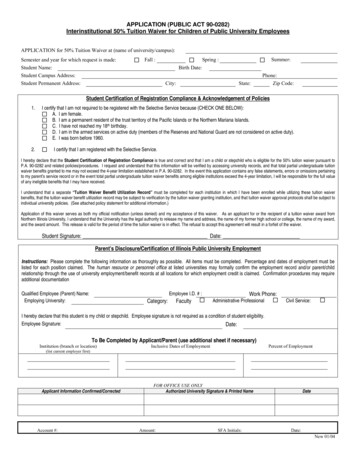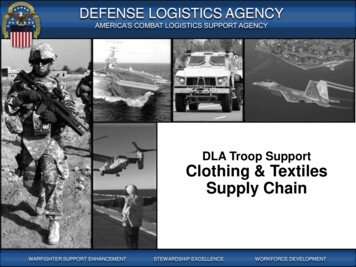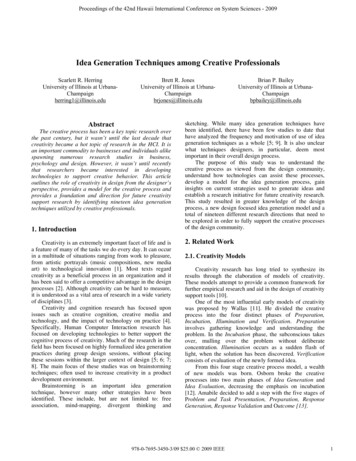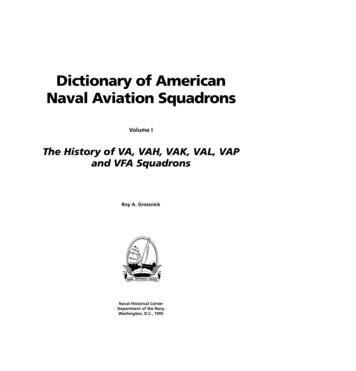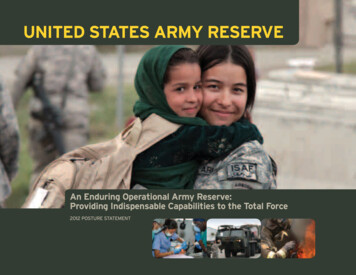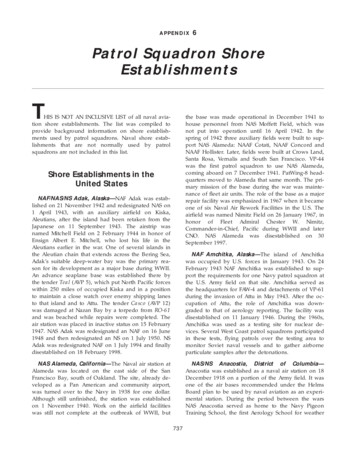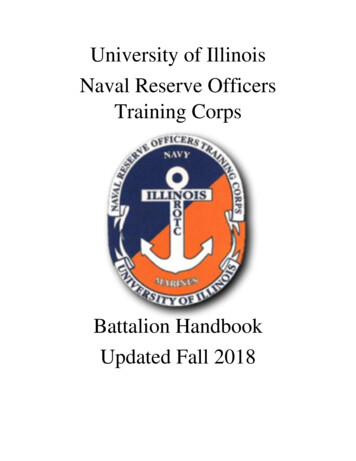
Transcription
University of IllinoisNaval Reserve OfficersTraining CorpsBattalion HandbookUpdated Fall 2018
DEPARTMENT OF THE NAVYNAVAL RESERVE OFFICER TRAINING CORPSUNIVERSITY OF ILLINOIS505 EAST ARMORY AVENUECHAMPAIGN, IL 61820-698321 Aug 18MEMORANDUMFrom:To:Subj:Battalion Commander, University of Illinois NROTCUniversity of Illinois NROTCFALL 2018 BATTALION COMMANDER’S INTENT1. Mission. To train midshipmen through physical fitness,professional knowledge, and leadership billets. We will foster acommand climate that facilitates critical thinking and decision makingin order to forge motivated individuals ready to take on their rolesas leaders in the United States Navy and Marine Corps.2. Vision. By the end of the semester, midshipmen will have gainedconfidence in their leadership abilities and developed physically andprofessionally while contributing to a command climate that encouragesparticipation in unit events and a sense of comradery.3.Command Pillars.a. Accountability. Midshipmen are expected to takeresponsibility for all duties relevant to their billet. Failure tomeet my expectations will result in disciplinary action leading up toloss of the billet and recommendation for PRB.b. Unselfishness. Effective leaders must be willing toprioritize their subordinates over themselves. I expect allmidshipmen in leadership positions to utilize their commandresponsibly so that they are not asking their subordinates to doanything they themselves would not do. Hazing of any kind will not betolerated.2
c. Respect. In order to function at its best, the battalion’scommand climate must allow midshipmen to work together in a respectfuland tactful manner. Discrimination on the basis of race, gender,sexual orientation, or religion will not be tolerated.d. Active Participation. When the bulk of the work is handled bya few midshipmen, morale and unit efficiency suffers. I expect allmidshipmen to strive to participate in all available training, so theunit may grow stronger as a whole.4. Lines of Operation. In order to achieve the aforementionedvision, the battalion will execute the mission according to thefollowing plan.a. Freedom to Take Risks. Midshipmen in leadership positionswill be encouraged to take risks and experiment with their leadershipstyles. I encourage all my staff to think creatively and be bold withtheir decision making.b. Timeliness and Advance Planning. Assigned tasks will becompleted thoroughly and two weeks in advance of their deadline inorder to leave room for corrective action as the situation andoperating environment changes.c. Transparency of Command. In order to facilitateaccountability and organization, all meetings and issued orders willbe recorded and readily accessible to battalion staff, so there is nouncertainty regarding assigned tasks.M. L. MAH3
Table of ContentsI.Administrationa. Billet Descriptions.5b. Organizational Chart.14c. PRT / PFT / CFT Standards.15d. Battalion Awards.23e. Summer Cruise.26f. Uniform Regulations and Standards.27II.Academic and Training Requirementsa. Degree Requirements.34b. Navy Required Courses.35c. College Program / Advanced Standing Required Courses.35d. Marine Required Courses.36e. MECEP Required Courses.36f. STA-21 Required Courses.36III. Battalion Operationsa. Battalion Functions.36b. Midshipman Duty Officer.36c. Colors.37d. Duty Company/Platoon.374
I.Administrationa.Billet Descriptionsi.Billet:Battalion Commander (BnCO)1. Description: The BnCO is responsible for every actionin the battalion. All successes and failures are ultimately theBnCO’s responsibility. The BnCO creates a vision for the battalion asa whole then relies on their staff to carry out the vision.2. Main Duties: The BnCO will hold weekly or bi-weeklystaff meetings with the midshipmen staff and unit staff.Additionally, they are responsible for any Battalion Commander’s maststhat may occur. The BnCO also meets with the unit Commanding Officer(CO) weekly for mentoring and to inform them of any updates within thebattalion.3. Supplemental Duties: The BnCO should provide anintent for every evolution and relay this intent to their staff inorder to allow them to carry out the mission. They must ensure thattheir subordinates are completing the tasks at hand. During weeklystaff meetings, the BnCO should report intent and progress of intent.the BnCO.4.Direct Superior:5.Unit Mentor:UIUC NROTC Commanding OfficerCommanding Officer and Executive Officer6. Tips: Communication and delegation are imperative forThe BnCO is the link from unit staff to midshipmen staff.ii.Billet:Battalion Executive Officer (BnXO)1. Description: The BnXO is second in command within themidshipmen ranks. They are responsible for finding the best way toexecute the BnCO’s intent.2. Main Duties: BnXO should be active in guiding thedirection of the battalion’s movement. Additionally, they shouldadvise the BnCO. The relationship between the BnCO and BnXO is key tothe success of the battalion.3. Supplemental Duties: BnXO must uphold the standardsfor discipline within the unit. They are responsible for theOperations Officer (OPS), Public Affairs Officer (PAO), Adjutant(ADJ), and Supply Officer (SUPPO). The BnXO also attends BattalionCommander’s masts and reports the progress of the battalion duringweekly staff meetings.5
4.Direct Superior:5.Unit Mentor:BnCOExecutive Officer6. Tips: Utilize your staff effectively. Communicateearly and often. Hold yourself to the highest standard.iii.Billet:Company Commander (CoCDR)1. Description: The CoCDR is responsible for the welfareof all members within the company. The CoCDR is ultimatelyresponsible for the successful completion of all events that thecompany participates in. This includes managing personnel as well asthe timely completion of assigned duties.2. Main Duties: CoCDRs must communicate the Plan of theWeek (POW) effectively with their company advisor, other midshipmen onstaff, and subordinates. The CoCDR must have a PT plan to present tothe company advisor and OPS each week.3. Supplemental Duties: The CoCDR is ultimatelyresponsible for the timely muster of all company members at allcompany events. These events include physical training, duty platoon,drill periods, and any other events. The CoCDR will counsel membersof their company when necessary (after a second disciplinary offense).The CoCDR also attends Battalion Commander’s mast if the accused is intheir company. CoCDRs report progress on events and their companyduring weekly staff meetings.(a) Alpha: Responsible for the execution of NavalBall during Fall semester and Honors Day during Spring semester.(b) Bravo: Responsible for the execution of theVeteran’s Day Ceremony during Fall semester and Dining In duringSpring semester.(c) Charlie: Responsible for organizing MOLAB andexecuting training cycles for FEX and Bulldog Prep (BDP) during Springsemester.(d) Delta: Responsible for the development andoversees mentorship of 4/C Midshipmen.4.Direct Superior:5.Unit Mentor:BnCOCompany Advisors6. Tips: Be yourself, accept criticism, and learn fromyour mistakes. Communicate with your company advisor and your commandtriad (CoCDR, CoXO, and CoCPO) for maximum success. Utilize MECEPsand OCs for training cycles in which you are not as experienced in.6
iv.Billet:Delta Company Commander1. Description: The Delta Company Commander will developthe 4/C throughout the Fall semester by acting as their primary mentorand leader, and will also be in charge of designing and implementingthe Freshman Development Program.2. Main Duties: The Delta Company Commander must ensurethe 4/C are developing adequately to get them up to the standards ofthe battalion. The Freshman Development Program must be bothchallenging and beneficial to the growth of the 4/C.3. Supplemental Duties: The Delta Company Commanderworks to develop the 4/C by tracking their academics, health, andphysical fitness. They also report the progress of 4/C during weeklystaff meetings.4.Direct Superior:5.Unit Mentor:BnCODelta Company Advisor6. Tips: Be actively engaged in the lives of the 4/C.Work closely with the NSO MIC to properly create a training plan thatdraws on skills and knowledge learned during INDOC and NSO.v. Billet: Battalion Sergeant Major/Master Chief PettyOfficer(BnSgtMaj/MCPO)1. Description: The Battalion Sergeant Major/ MasterChief Petty Officer is the senior enlisted Billet in the battalion.The person in this billet must set the standard for proper conduct andprofessionalism in the battalion.2. Main Duties: BnSgtMaj/MCPO must keep accountabilityat all times. This involves tracking who has CHITS and knowing howmany Midshipmen should be present at PT. This also involves keepingan up to date disciplinary policy, documenting who has committed adisciplinary infraction and what disciplinary action was taken, andreporting such information during weekly staff meetings.3. Supplemental Duties: The senior enlisted billet willensure that unit spaces are clean and orderly at all times. They willalso decide when formal inspections of the battalion will occur.Additionally, they attend and help lead Battalion Commander’s mast.The BnSgtMaj/MCPO begins weekly staff meetings by notifying the XOwhen all midshipmen staff members are present.4.Direct Superior:5.Unit Mentor:BnCOAssistant Marine Option Instructor(AMOI)7
6. Tips: While carrying out duties, be sure to promote aprofessional and disciplined environment. Midshipmen will look to theBnSgtMaj as the example of good order and conduct.vi.Billet:Adjutant (ADJ)1. Description: The Adjutant is responsible for passingword via the Battalion Word (BnWord) email and the organization ofstudy hours.2. Main Duties: ADJ must send out the BnWord in a timelyfashion, report study hour violations, and create a battalion drive.This Battalion Drive will be maintained and regularly updated by theAdjutant. Additionally, they will ensure the proper completion ofFITREPS and SITREPS when necessary.3.command recall,battalion drivehour violationsSupplemental Duties: ADJ maintains an up to datedelegates the recording of study hours, and keeps theorganized and easy to use. They also report studyduring weekly unit staff meetings.4.Direct Superior:5.Unit Mentor:BnXOExecutive Officer, Academic Officer6. Tips: Coordinate and communicate effectively withyour fellow staff members to assure that correct and accurateinformation is sent out via the BnWord.vii.Billet:Training Officer (TRAINO)1. Description:of the battalion.The TRAINO oversees the physical fitness2. Main Duties: The TRAINO creates physical fitnessplans for the battalion and administers PFT/PRTs. TRAINO will meetweekly with the Command Fitness Leader (CFL) to approve PT memos forboth battalion PT and FEP.3. Supplemental Duties: The TRAINO will create/oversee aPT incentive program, plan Tri-ROTC fitness events, and update therecord board. They also report the training plan for the week duringweekly staff meetings.4.Direct Superior: BnXO5.Unit Mentor: Command Fitness Leader6. Tips: Work closely and communicate with both thebattalion and unit staff. Look closely at PFT/PRT results and plan asemester workout plan accordingly.8
viii.Billet:Public Affairs Officer (PAO)1. Description: The PAO represents the University ofIllinois NROTC by maintaining a social media presence, cooperatingwith the University of Illinois to inform incoming students about theunit, and by providing information to anyone interested in thebattalion.2. Main Duties: The PAO must maintain and update theNROTC website frequently and post on the Facebook page about battalionactivities. The PAO also releases monthly newsletters on battalionevents.3. Supplemental Duties: PAO sets up the NROTC tailgatesin the Fall. Additionally, the PAO takes pictures of every battalionevent and makes the pictures accessible on the battalion drive. Also,they must report monthly newsletter and event updates during weeklystaff meetings.4.Direct Superior:5.Unit Mentor:BnXOStaff PAO6. Tips: Be ready to take on projects that could includeworking with alumni, staff, and community groups within or outside theUniversity. Don’t be afraid to brainstorm ideas that will help thePAO team enhance the battalion’s presence. Build and utilize yourteam efficiently and effectively. Delegation is key to success inthis billet.ix.Billet:Operations Officer (OPS)1. Description: The OPS oversees planning and schedulingof major battalion events and weekly events.2. Main Duties: The main responsibilities includeplanning weekly drill session’s content and preparing the POW coveringall battalion events for the week. OPS will also meet with unit staffweekly to get the POW approved and ensure General Military Training(GMTs) are completed throughout the semester.3. Supplemental Duties: The OPS works with the CoCDRs,TRAINO, and Lab MICs to ensure coordinate event planning. They mustalso report the drill schedule and future events during weekly staffmeetings.4.Direct Superior:5.Unit Mentor:BnXOStaff Operations Officer6. Tips: Maintain constant communication with all staffmembers to ensure all events are planned in advance so that no details9
are overlooked. Make sure the entire operations staff is keptinformed of all events.x.Billet:Supply Officer (SUPPO)1. Description: The SUPPO is responsible for carryingout all tasks assigned by the Supply Technician. They must alsomaintain and disperse inventory as necessary. Additionally, SUPPOworks closely with the comptroller.2. Main Duties: The SUPPO must issue proper uniforms andnecessary gear to Midshipmen, keep accurate inventory on supplies, andhold an appropriate amount of SUPPO hours for midshipmen in thebattalion to attend when necessary.3. Supplemental Duties: SUPPO maintains the online storeand keeps ink and paper in printers in the Wardroom. They also reportnew inventory and merchandise updates during weekly staff meetings.4.Direct Superior:5.Unit Mentor:BnXOSupply Technician6. Tips: Use the Supply Technician as a resource.Utilize your staff (one chief and a clerk) and delegate as needed.xi.Billet: Comptroller (COMP)1. Description: Comptroller manages all unit funds andarranges budgets and payments for major battalion events.2. Main Duties: COMP acts as the manager of theMidshipman Rec Fund, balances the budget, creates budget limits formajor events, reimburses battalion members for qualified expenses,meets weekly with the unit advisor, assists in fundraising, managesthe RSO account, applies for SORF funding for every major battalionevent, and ensures detailed records are kept for tax/audit purposes.3. Supplemental Duties: COMP renews and maintainsliability insurance, renews the battalion as an RSO, ensuresfundraising spots are filled, and works on complete digitization ofunit finances. They also report budget and expenses during weeklystaff meetings.4.Direct Superior: BnXO5.Unit Mentor: Morale, Welfare and Recreation (MWR)Officer6. Tips: Your most useful tools are your advisor,civilian staff, your binder, and the previous comptroller. You mustbe trained by the previous comptroller in order to succeed.10
xii.Billet:Company Executive Officer (CoXO)1. Description: The CoXO is second in command within theCompany. They are responsible for finding the best way to execute theCoCDR’s intent.2. Main Duties: The main duty of the CoXO is to be theright-hand of the CoCDR. They should be active in executing theintent and commands of the CoCDR.3. Supplemental Duties: The CoXO upholds the standardsand sets the bar for discipline within the company. They areresponsible for the Company Chief Petty Officer (CoCPO) and willattend weekly staff meetings in the case that the CoCDR cannot.4.Direct Superior:5.Unit Mentor:CoCDRCompany Advisors6. Tips: Be proactive and take initiative. The CoCDRmay not always be clear or ask for help when actually desired.xiii. Billet: Company Chief Petty Officer/Company 1st Sergeant(CoCPO/Co1stSgt)1. Description: The CoCPO is the senior enlisted billetfor the company.2. Main Duties: The CoCPO is responsible for taking andmaintaining counts of the company and reporting them to the CoXO.They must track and report those who are late or have an unauthorizedabsence (UA) to battalion events.3. Supplemental Duties: The CoCPO will ensure thatstandards are met within the company. They are an extension of theBnSgtMaj/MCPO and will lead weekly field day inspections for theirrespective company. They must also receive counts from theirMustering Petty Officers (MPOs) or Platoon Sergeants (PltSgts) atbattalion events.4.Direct Superior:5.Unit Mentor:CoXOAMOI6. Tips: Keep a notepad to track numbers, and find asystem that suits you best to track disciplinary actions.xiv.Billet:Platoon Commander (PltCo)1. Description: The PltCo is the officer billetresponsible for the actions and well-being of their platoon.11
2. Main Duties: The PltCo ensures their platoon isperforming as necessary to meet battalion standards.3. Supplemental Duties: PltCo personally inspects theplatoon during a formal inspection and is responsible for the growthand well-being of their squads.4.Direct Superior:5.Unit Mentor:CoCPOCompany Advisors6. Tips: Get close to your platoon help them succeed inthe battalion. The Platoon Commanders is the closest leadershipbillet to the squads of the platoon, so take this opportunity to workon leadership styles and techniques.xv. Billet: Mustering Petty Officer/Platoon Sergeant(MPO/PltSgt)1. Description:the platoon level.The MPO is the senior enlisted billet at2. Main Duties: The MPO takes and maintains counts ofthe platoon and reports them to the PltCo and CoCPO. The MPO willtrack and report those who are late or UA to battalion events andassist the PltCo as necessary. The MPO will perform counselings andensure that progress is being made in the platoon’s discipline anddevelopment.3. Supplemental Duties: The MPO ensures that uniform andbehavioral standards are met within the platoon. They are anextension of the CoCPO and act as a scribe for PltCo during formalinspections. They are also responsible for collecting informationfrom squad leaders.4.Direct Superior:5.Unit Mentor:PltCoCompany Advisors6. Tips: Take the initiative during PT and make use ofsmall unit leadership.xvi.Billet:1.their squad.Squad LeaderDescription:The Squad Leader is the senior member of2. Main Duties: The Squad Leader takes and maintainscounts of the squad and reporting them to the MPO. They will trackand report those who are late or UA to battalion events and willassist the MPO as necessary.12
3. Supplemental Duties: The Squad Leader is responsiblefor their squad members, setting the example, and assists them asnecessary.4.Direct Superior:5.Unit Mentor:6.Tips:MPOCompany AdvisorLearn from the MPO and get to know your squadmembers.xvii.Billet: Squad Member1. Description: A squad member is responsible forgetting to battalion events on time and maintaining battalionacademic, physical, and aptitude standards.2. Main Duties: A Squad Member must arrive on time toall battalion events. They are to learn how to integrate with thebattalion and develop as a future leader in the battalion.3. Supplemental Duties: A Squad Member will volunteer forconcessions or other supplemental battalion events.4. Direct Superior:5.Unit Mentor:Squad LeaderCompany Advisors6. Tips: Be proactive and learn how the battalion worksso as to become an integral part of the battalion. Learn to be afollower, and cooperate with the leadership billets appointed overyou, so that they may develop as well.13
b.Organizational Chart14
c.PRT/PFT/CFT Standardsi. Navy Options are required to score at least a “Good-Low”in each category on the Physical Readiness Test (PRT) in order to stayoff the Fitness Enhancement Program. Midshipmen, regardless of theirage, are graded on the age scale of 20-24. The scores are found inthe chart below.PRT Score Chartii. Marine Options are required to score at least 265 on thePhysical Fitness Test (PFT) in order to stay off FEP. The scorecharts for the PFT are listed below.15
PFT Score Charts16
17
18
iii. Marine Options are required to take the Combat FitnessTest (CFT), which consists of three events: Movement to Contact, AmmoCan Lift, and Maneuver Under Fire. Movement to Contact is an 880-yardsprint, after which Midshipmen will rest for five (5) minutes, thenexecute the Ammo Can Lift event. Midshipmen will have two (2) minutesto do as many Ammo Can lifts as possible before resting for five (5)minutes. Midshipmen will then conduct the Maneuver Under Fire event.The Maneuver Under Fire event consists of a 300-yard shuttle run withvarious combat-related tasks, including crawls, carries, ammunitionresupply, grenade-throwing, and agility running. Midshipmen mustscore 235 in order to pass. The score charts for the CFT are listedon the following pages.19
CFT Score ChartsManeuver Under Fire20
21
22
d.Battalion AwardsAwardRibbonDescriptionAll AroundPerformanceDesigned to recognize NROTCmidshipmen for the mostoutstanding performance in thefield of academics, physicalfitness training, communityservice, and military conduct.Awarded by the BattalionCommander.AcademicExcellenceAwarded every semester tomidshipmen with a GPA of 3.50– 4.00. Awarded by Unit Staff.AcademicAchievementAwarded every semester tomidshipmen with a GPA of 3.30– 3.50. Awarded by Unit Staff.NSO HonorGraduateAwarded to thecandidate thatas number 1 inAwarded by theLeadershipAwardAwarded to midshipmen who haveshown exemplary conduct andleadership as members ofbattalion staff. Awarded byany Midshipman O-4 or abovewith the approval of theBattalion Commander.CommunityService AwardAwarded to those recognizedfor services to the community.Awarded when approximately 50community service hours arecompleted during an academicyear outside of ROTC events.Awarded by any Midshipman O-4or above with approval of theBattalion Commander.PhysicalFitnessAwarded to those with a scoreon the PFT of 290 points orhigher, or a PRT score of23midshipmangraduated NSOtheir class.NSO MIC.
outstanding or higher. Awardedby Unit Staff.Color PlatoonAwarded to the members andleadership of the colorplatoon. Awarded by theBattalion Commander.Endurance TeamAwarded to any midshipman whowas a member of the enduranceteam for one academicsemester. Awarded by theEndurance Team Commander.Drill TeamAwarded to midshipmencompeting in any drill teamcompetition for one academicsemester. Awarded by the DrillTeam Commander.Color GuardAwarded to midshipmen whoparticipated in at least fivecolor guard events. Awarded bythe Color Guard Commander.IntramuralsAwarded to those whoparticipated in any organizedsports for one academicsemester. Awarded by the TeamsMIC.Rifle-PistolTeamAwarded to any member of therifle/pistol team for oneacademic semester. Awarded bythe Rifle-Pistol TeamCommander.Sailing AwardAwarded to midshipmen whoqualify as Skippers B duringCORTRAMID. Authorized to wearonce qualified.Society ofMilitaryEngineersAwarded by the Society ofMilitary Engineers.Reserve OfficerAssociationAwarded by the Reserve OfficerAssociation.American LegionAwarded by the AmericanLegion.24
Veterans ofForeign WarsAwarded by the Veterans ofForeign Wars.AmericanVeteransAwarded by the AmericanVeterans.Sons of theAmericanRevolutionAwarded by the Sons of theAmerican Revolution.Daughters ofthe AmericanRevolutionAwarded by the Daughters ofthe American Revolution.NationalSojournersAwarded by the NationalSojourners.Other RibbonsAny other ribbons from outsideorganizations will be wornbelow the National SojournersAwarde.Summer Cruise (scholarship MIDN only)i. It is important to note that these cruises are what youmake of them. Ask questions and be proactive to get as muchinformation and vital experience as possible to help you choose thecommunity that best suits you.ii. Visit the following website for all information regardingsummer cruises:http://www.nrotc.navy.mil/training info.html25
ClassTraining4/C becoming 3/CCORTRAMIDDescription4-week training cycle designed to helpyou decide which community you want tojoin. You will spend a week with eachcommunity: surface warfare, aviation,submarine, and Marine Corps. Thistraining takes place in either SanDiego, CA in the first half of thesummer or in Norfolk, VA in the secondhalf of the summer.3/C becoming 2/C2/C CruiseGenerally a 2-6 week cruise of yourpreference where you are attached to anenlisted running mate to experiencelife in the fleet as enlistedpersonnel.2/C becoming 1/C1/C CruiseGenerally a 2-6 week cruise of yourpreference where you see what life islike in the fleet as an ine Options will attend OfficerCandidates School in order tocommission after graduating.Uniform Regulations and Standardsi.Service Khaki(a)Garrison Cover1. The cover is worn squarely on the head, withfore and aft crease centered vertically between the eyebrows and thelowest point, approximately 1 inch above the eyebrows.2. Insignia for both Navy and Marine Options isworn on the left side of the cover 2” to the left of the center of thefront of the cover and 1 ½” from the bottom of the cover26
(b)Ribbons and Nametape1. Ribbons will be centered on the left chestpocket 1/4” above the pocket for Navy Options and 1/8” for MarineOptions.2. Nametape will be centered on the right chestpocket 1/4” above the pocket for Navy Options and 1/8” for MarineOptions.(c)Insignia and Rank1. Insignia and rank will be worn on the collar1” down each side of the collar, centered.2. See Midshipmen Rank and Class Insignia forappropriate collar device.(d)Belt and Gig Line1. For Navy Options, the belt tip is flush withthe edge of the buckle. The belt should not be seen between the tipand the buckle. For Marine Options, the tip is 2 to 4 inches to theleft of the buckle.2. The gig line is the alignment of the left tipof the belt buckle with the seam of your blouse and trousers formales, left image, and the alignment of the right tip for females,right image.27
(e)Relaxed Fit Jacket/All-Weather Coat1. Relaxed Fit Jacket will be zipped up at least3/4 of the way up. All buttons except the collar button will bebuttoned for All-Weather Coat.2. Officer billets will wear their insigniacentered on the shoulder straps ¾” from the squared end of theshoulder strap.ii.Service Dress Blues (SDB)(a)Cover1. A white combination cover is worn with SDBs. Thiscover is worn squarely on the head with the bottom edge parallel toand 1 ½ inches above the eyebrow.2. Navy Options will have anchor insignia on thefront of the cover while Marine Options will have EGA.3. Brim of cover will be shiny and rid offingerprints or scratches. Cover will be white and will be washed ifdirty.(b)Ribbons and Nametape1.Ribbons – See Service Khaki, Ribbons and Nametape.2. Nametape will be aligned with ribbon rack as theright side of the SDB does not have a pocket to reference.28
(c)Insignia and Rank1. Insignia will be centered on each lapel of thejacket of the SDB, 1/2 inch above the bottom of the lapel. NavyOptions will wear anchors while Marine Options will wear EGAs.2. Midshipman Officers will wear stripes of goldnylon on both sleeves of the SDB jacket. The stripes will be centeredon the outer side of the sleeve with the lower stripe 2 inches aboveand parallel to the edge of the cuff.3. Midshipmen will also wear soft shoulder boards onboth shoulders of white collared undershirt. See Midshipmen Rank andClass Insignia for appropriate shoulder board.(d)Belt and Gig Line1.(e)See Service Khaki, Belt and Gig LineBlack Tie1. Tie will be tied in either a four-in-hand orWindsor knot around collar covering top button with appropriatetightness.2. Gold tie clasp will be attached so that it iscentered in between the top and bottom of the pocket of the whitecollared undershirt.29
iii.Summer Whites(a)Cover1.(b)Ribbons and Nametape1.(c)See Service Khaki, Ribbons and Nametape.Belt and Gig Line1.iv.See Service Khaki, Ribbons and Nametape.Insignia and Rank1.(d)See SDB, Cover.See Service Khaki, Belt and Gig Line.Navy Working Uniform (NWU) Type III(a)Cover1. The cap will be worn squarely on the head so thatthe visor is straight, just above the level of the eyes and parallelwith the deck.(b)Ribbons and Nametape1.Ribbons will not be worn.2. Nametape will be sewn centered above and flushwith the top of the right pocket.3. “U.S. NAVY” will be sewn centered above and flushwith the top of the left pocket.(c)Insignia and Rank1. Appropriate class or Officer insignia will be worncentered on the chest strap of the blouse. Pictures of properinsignia orientation are pictured below30
MIDN 1/C(d)MIDN 3/CBelt and Gig Line1.v.MIDN 2/CSee Service Khaki, Belt and Gig Line for males.MARPAT(a)Cover1. The cap will be worn squarely on the head so thatthe visor is straight, just above the level of the eyes and parallelwith the deck.(b)Ribbons and Nametape1.Ribbons will not be worn.2. Nametape will be sewn centered above and flushwith the top of the right pocket.3. “U.S. MARINES” will be sewn centered above andflush with the top of the left pocket only after graduating from OCS.Insignia and rank will be worn on the collar 1” down each side of thecollar, centered.4. Fourth-class Marine Options will wear no collardevice, third-class will wear one (1) EGA on the right collar, andsecond-class and first-class will wear an EGA on both collars.(c)Belt and Gig Line1.See Service Khaki, Belt and Gig Line for males.31
vi.Midshipman Rank and
NAVAL RESERVE OFFICER TRAINING CORPS UNIVERSITY OF ILLINOIS 505 EAST ARMORY AVENUE CHAMPAIGN, IL 61820-6983 21 Aug 18 . as leaders in the United States Navy and Marine Corps. 2. Vision. By the end of the semester, midshipmen will have gained . and OCs for training cycles in which you are not as experienced in. 7 iv. Billet: Delta Company .
